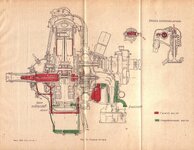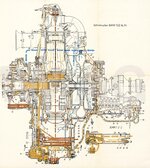Well, i probably said this with other occasions, but what Germany really lacked was a mid-1930s 14 cylinder radial equivalent to say the GR14K, at about 36-37 litres or so. For this, instead of competing with BMW, Bramo would be in an ideal position to design a 14 cylinder radial instead of the Bramo-323. Let's call it Bramo-324. Initially it would be good for what, 1100-1200 PS? Then the later two-speed variant should be good for 1300-1350 PS? I see it primarily used in the Do-17 variants where it would give it some much needed extra power. FW-200 would benefit too, or Ju-90 and i'm sure other aircraft i can't think of right now.
Of course, in this ATL BMW and Bramo should never be merged. BMW should entirely focus on improving the BMW-132 instead of BMW-116/117 inlines, the 132 badly needs better 2-speed superchargers, and then work on the 14 cylinder BMW-139 of 1500 PS, but with 3 separate bearings from the start if it's to be usable. It will then entirely focus on improving it up to 2000 PS instead of wasting time with any 18 or 28 cylinder projects. Bramo would then at the same time work on an 18 cylinder of 2000 PS, the Bramo-300 or whatever it will be called. And for the duration of the war focus on improving it up to at least 2500 PS.
As far as mergers, Argus could be merged into BMW or Bramo for instance, their air-cooled inlines beyond the As-410 and other fancy projects of theirs are a waste of time so their capacities would be better used supporting something that already works. They did build BMW engines under licence in OTL anyway.
Of course, in this ATL BMW and Bramo should never be merged. BMW should entirely focus on improving the BMW-132 instead of BMW-116/117 inlines, the 132 badly needs better 2-speed superchargers, and then work on the 14 cylinder BMW-139 of 1500 PS, but with 3 separate bearings from the start if it's to be usable. It will then entirely focus on improving it up to 2000 PS instead of wasting time with any 18 or 28 cylinder projects. Bramo would then at the same time work on an 18 cylinder of 2000 PS, the Bramo-300 or whatever it will be called. And for the duration of the war focus on improving it up to at least 2500 PS.
As far as mergers, Argus could be merged into BMW or Bramo for instance, their air-cooled inlines beyond the As-410 and other fancy projects of theirs are a waste of time so their capacities would be better used supporting something that already works. They did build BMW engines under licence in OTL anyway.
Last edited:




